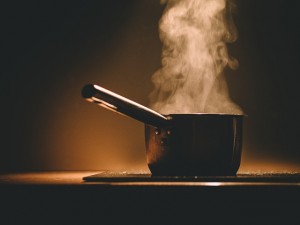
Public domain photo via pixabay.com
So let’s get to it!
Boiling
This means to bring any type of liquid to a boil. The boiling point is generally 212 degrees. Boiling is usually accomplished when bubbles have broken the surface of the liquid.
Bone
When you see this in a cookbook, it is generally telling you that you will need to remove any bones from the meat.
Braise
With this cooking technique, you brown the meat first and then place it in a pot with liquid. Then you tightly cover the pot and slowly cook the meat.
Caramelize
This is the art of putting sugar atop of any food dish, then using high heat to melt it. You can also caramelize sweet foods, like onions, by cooking them in a pan with oil until they form a sticky brown film.
Coddle
Using hot water, you slow cook eggs.
Dice
A cubed form of cutting vegetable, fruits, and meats. Typically, when dicing the cubes are about 1/4 of an inch wide.
Dollop
This is a measurement of food. Generally, it is not defined in any way accept to say one or two dollops and is typically used for softer foods like sour cream or whipped cream. For me, a dollop is usually a heaping table spoon.
Drippings
These are the fats that have melted when using a pan to cook meat.
Soft Crack
This is a term used when making candies. This stage can be determined by testing the syrup in some cold water, after the syrup has boiled. If when dropped into the water, it quickly forms pliable, but hot threads, it has reached the soft crack stage. It is usually best to use a candy thermometer, which will show a soft crack stage of 270 to 290 degrees.
Abbreviations
Tablespoon – T or Tbsp
Teaspoon – t or tsp
Gallon – Gal
Ounce – Oz
Fluid – Fl
Pint – Pt
Cup – C
Quart – Qt
Pound – Lb
Equivalents
Dash – This is usually 1/4 teaspoon
Juice – Depending on the fruit, lemon equals 3 Tbsp of lemon juice, orange equals a 1/2 cup of orange juice.
Pinch – This is equivalent to 1/8 teaspoon
Other equivalents can often be found in your cookbook or by looking them up on the Internet. Here are some resources I’ve used:

